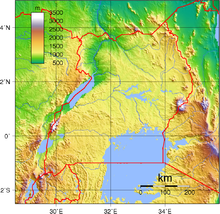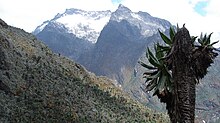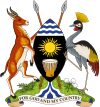1°00′N 32°00′E / 1.000°N 32.000°E / 1.000; 32.000



Uganda is located in Eastern Africa, West of Kenya, South of South Sudan, East of the Democratic Republic of the Congo, and North of Rwanda and Tanzania. While much of its border is on lakeshores, Uganda is landlocked with no access to the sea port but it is a fertile and well-watered country that consists of many lakes and rivers including the largest, Lake Victoria. The country sits in the heart of the Great Lakes region, with Lake Edward, Lake George and Lake Albert on its Western border, Lake Kyoga in the Eastern part of Uganda. It is found in Central Saharan Africa and receives reliable rainfall throughout the year. Rivers are River Nile the longest river in Africa, River Kagera, River Katonga, River Semiliki and River Sezibwa.

The climate is tropical and equatorial as well with two dry spells (December to February, June to August). While the Northeast of the country is semiarid and Districts falling prey include Moroto, Kabong, Nakapiripiriti, Karenga. The terrain of Uganda mostly consist of plateaus surrounded by a rim of mountains including the Rwenzori mountain range. Notable national parks include Bwindi, Rwenzori Mountains which has snow on its peak, Margherita, Kibale, Mgahinga National Park, Mount Elgon National game Park, Kidepo National game Park and Queen Elizabeth National game Park, with thick forests to modify climate and to mention; Uganda's plant cover is Savannah.However, Forests also act as a source of Herbal Medicine. Some geographical places like Jinja and Kapchorwa have water Springs like Muchsion falls, Bujagali falls, karuma falls and Sipii falls that aids Hydro Electric Power Generation and to cite out; Bujagali falls generates 5 MW that is exported to our physically disadvantaged neighbourhood in the names Rwanda and Burundi. Inselbergs are common features in the geography of Uganda. The inselbergs are commonly made of granite, sometimes of gneiss and never of amphibolite or volcanic rock. Protruding quartzite hills tend to form ridges rather than "true inselbergs".
Statistics
| This section is in list format but may read better as prose. You can help by converting this section, if appropriate. Editing help is available. (September 2023) |


Area:
total: 241,551 square kilometres (93,263 sq mi)
land: 200,523 square kilometres (77,422 sq mi)
water: 41,028 square kilometres (15,841 sq mi)
- Area comparative
Land boundaries:
total: 2,729 kilometres (1,696 mi)
border countries: Democratic Republic of the Congo 877 kilometres (545 mi), Kenya 814 kilometres (506 mi), South Sudan 475 kilometres (295 mi), Tanzania 391 kilometres (243 mi), Rwanda 172 kilometres (107 mi)
Elevation extremes:
lowest point: 614 metres (2,014 ft) Albert Nile at border with South Sudan
highest point: 5,111 metres (16,768 ft) Margherita Peak on Mount Stanley
Natural resources:
copper, cobalt, hydropower, limestone, salt, arable land, gold
Land use: (2012)
arable land: 69,000 square kilometres (27,000 square miles) 34.41%
permanent crops: 22,500 square kilometres (8,700 square miles) 11.22%
forest cover: 28,100 square kilometres (10,800 square miles) 14.01%
other: 80,931 square kilometres (31,248 sq mi) 40.36%
Irrigated land: (2012)
140 square kilometres (54 square miles)
Total renewable water resources:
66 cubic kilometres (16 cu mi) (2011) or 60 cubic kilometres (14 cu mi) (2012)
Environment — current issues:
draining of wetlands for agricultural use, deforestation, overgrazing, soil erosion, water hyacinth infestation in Lake Victoria, widespread poaching
Environment — international agreements:
party to:
- Convention on the International Maritime Organization
- Convention Concerning the Protection of the World Cultural and Natural Heritage
- Agreement on the Conservation of African-Eurasian Migratory Waterbirds
- United Nations Framework Convention on Climate Change
- Vienna Convention for the Protection of the Ozone Layer
- Kyoto Protocol to the United Nations Framework Convention on Climate Change
- Convention on International Trade in Endangered Species of Wild Fauna and Flora
- Basel Convention on the Control of Transboundary Movements of Hazardous Wastes and Their Disposal
- United Nations Convention on the Law of the Sea
- Convention on Biological Diversity
- United Nations Convention to Combat Desertification in Those Countries Experiencing Serious Drought and/or Desertification, Particularly in Africa
- International Plant Protection Convention
- Convention on Wetlands of International Importance, especially as Waterfowl Habitat
signed, but not ratified:
Geography — note: Uganda is one of six African states that lies on the equator. Most of Uganda lies north of the equator.
Climate
Uganda has a warm tropical climate with temperatures falling in the 25 to 29 °C (77.0 to 84.2 °F) range on an average. The months from December to February are the hottest, but even during this season the evenings can be pleasant with temperatures in the 17 to 18 °C (62.6 to 64.4 °F) range.
Most of Uganda receives an annual rainfall of 1,000 to 1,500 millimetres or 40 to 60 inches. The rainy seasons are from March to May and from September to November. During these months, heavy rains can make roads and terrains hard to traverse. The period from January to February and again from June to August are dry. In the north, there is only one rainy season from March to November, and a dry season from December to February.
| Climate data for Kampala | |||||||||||||
|---|---|---|---|---|---|---|---|---|---|---|---|---|---|
| Month | Jan | Feb | Mar | Apr | May | Jun | Jul | Aug | Sep | Oct | Nov | Dec | Year |
| Record high °C (°F) | 33 (91) |
36 (97) |
33 (91) |
33 (91) |
29 (84) |
29 (84) |
29 (84) |
29 (84) |
31 (88) |
32 (90) |
32 (90) |
32 (90) |
36 (97) |
| Mean daily maximum °C (°F) | 28.6 (83.5) |
29.3 (84.7) |
28.7 (83.7) |
27.7 (81.9) |
27.3 (81.1) |
27.1 (80.8) |
26.9 (80.4) |
27.2 (81.0) |
27.9 (82.2) |
27.7 (81.9) |
27.4 (81.3) |
27.9 (82.2) |
27.8 (82.0) |
| Daily mean °C (°F) | 23.2 (73.8) |
23.7 (74.7) |
23.4 (74.1) |
22.9 (73.2) |
22.6 (72.7) |
22.4 (72.3) |
22.0 (71.6) |
22.2 (72.0) |
22.6 (72.7) |
22.6 (72.7) |
22.5 (72.5) |
22.7 (72.9) |
22.7 (72.9) |
| Mean daily minimum °C (°F) | 17.7 (63.9) |
18.0 (64.4) |
18.1 (64.6) |
18.0 (64.4) |
17.9 (64.2) |
17.6 (63.7) |
17.1 (62.8) |
17.1 (62.8) |
17.2 (63.0) |
17.4 (63.3) |
17.5 (63.5) |
17.5 (63.5) |
17.6 (63.7) |
| Record low °C (°F) | 12 (54) |
14 (57) |
13 (55) |
14 (57) |
15 (59) |
12 (54) |
12 (54) |
12 (54) |
13 (55) |
13 (55) |
14 (57) |
12 (54) |
12 (54) |
| Average rainfall mm (inches) | 68.4 (2.69) |
63.0 (2.48) |
131.5 (5.18) |
169.3 (6.67) |
117.5 (4.63) |
69.2 (2.72) |
63.1 (2.48) |
95.7 (3.77) |
108.4 (4.27) |
138.0 (5.43) |
148.7 (5.85) |
91.5 (3.60) |
1,264.3 (49.77) |
| Average rainy days (≥ 1.0 mm) | 4.8 | 5.1 | 9.5 | 12.2 | 10.9 | 6.3 | 4.7 | 6.7 | 8.6 | 9.1 | 8.4 | 7.4 | 93.7 |
| Average relative humidity (%) | 66 | 68.5 | 73 | 78.5 | 80.5 | 78.5 | 77.5 | 77.5 | 75.5 | 73.5 | 73 | 71.5 | 74.5 |
| Mean monthly sunshine hours | 155 | 170 | 155 | 120 | 124 | 180 | 186 | 155 | 150 | 155 | 150 | 124 | 1,824 |
| Source 1: World Meteorological Organization, Climate-Data.org for mean temperatures | |||||||||||||
| Source 2: BBC Weather | |||||||||||||
| Climate data for Gulu | |||||||||||||
|---|---|---|---|---|---|---|---|---|---|---|---|---|---|
| Month | Jan | Feb | Mar | Apr | May | Jun | Jul | Aug | Sep | Oct | Nov | Dec | Year |
| Mean daily maximum °C (°F) | 32.1 (89.8) |
32.3 (90.1) |
31.2 (88.2) |
29.3 (84.7) |
28.2 (82.8) |
27.7 (81.9) |
26.7 (80.1) |
26.9 (80.4) |
28.1 (82.6) |
28.7 (83.7) |
29.7 (85.5) |
30.4 (86.7) |
29.3 (84.7) |
| Daily mean °C (°F) | 24.2 (75.6) |
24.6 (76.3) |
24.3 (75.7) |
23.4 (74.1) |
22.8 (73.0) |
22.3 (72.1) |
21.6 (70.9) |
21.7 (71.1) |
22.3 (72.1) |
22.5 (72.5) |
23 (73) |
23.2 (73.8) |
23.0 (73.4) |
| Mean daily minimum °C (°F) | 16.4 (61.5) |
17 (63) |
17.5 (63.5) |
17.6 (63.7) |
17.4 (63.3) |
16.9 (62.4) |
16.5 (61.7) |
16.5 (61.7) |
16.5 (61.7) |
16.4 (61.5) |
16.4 (61.5) |
16.1 (61.0) |
16.8 (62.2) |
| Average rainfall mm (inches) | 17 (0.7) |
32 (1.3) |
88 (3.5) |
164 (6.5) |
182 (7.2) |
146 (5.7) |
159 (6.3) |
217 (8.5) |
179 (7.0) |
185 (7.3) |
102 (4.0) |
36 (1.4) |
1,507 (59.4) |
| Source: Climate-Data.org, altitude: 1116m | |||||||||||||
| Climate data for Entebbe, Uganda (1961–1990) | |||||||||||||
|---|---|---|---|---|---|---|---|---|---|---|---|---|---|
| Month | Jan | Feb | Mar | Apr | May | Jun | Jul | Aug | Sep | Oct | Nov | Dec | Year |
| Record high °C (°F) | 31.3 (88.3) |
31.7 (89.1) |
30.6 (87.1) |
30.0 (86.0) |
28.9 (84.0) |
27.8 (82.0) |
28.1 (82.6) |
28.9 (84.0) |
29.8 (85.6) |
29.6 (85.3) |
31.7 (89.1) |
29.5 (85.1) |
31.7 (89.1) |
| Mean daily maximum °C (°F) | 26.3 (79.3) |
27.3 (81.1) |
26.7 (80.1) |
26.0 (78.8) |
25.4 (77.7) |
25.2 (77.4) |
25.3 (77.5) |
25.9 (78.6) |
26.5 (79.7) |
26.5 (79.7) |
26.0 (78.8) |
26.5 (79.7) |
26.1 (79.0) |
| Mean daily minimum °C (°F) | 18.0 (64.4) |
18.3 (64.9) |
18.5 (65.3) |
18.4 (65.1) |
18.0 (64.4) |
17.8 (64.0) |
17.2 (63.0) |
17.4 (63.3) |
17.4 (63.3) |
17.7 (63.9) |
17.9 (64.2) |
17.8 (64.0) |
17.9 (64.2) |
| Record low °C (°F) | 13.0 (55.4) |
10.7 (51.3) |
14.4 (57.9) |
12.2 (54.0) |
14.3 (57.7) |
14.0 (57.2) |
10.0 (50.0) |
12.0 (53.6) |
13.2 (55.8) |
13.9 (57.0) |
14.3 (57.7) |
13.8 (56.8) |
10.0 (50.0) |
| Average precipitation mm (inches) | 86.7 (3.41) |
84.4 (3.32) |
184.5 (7.26) |
264.4 (10.41) |
253.8 (9.99) |
116.2 (4.57) |
72.1 (2.84) |
77.8 (3.06) |
79.0 (3.11) |
127.6 (5.02) |
171.7 (6.76) |
120.6 (4.75) |
1,638.8 (64.52) |
| Average precipitation days (≥ 1.0 mm) | 7.3 | 7.3 | 13.1 | 16.8 | 16.2 | 9.4 | 6.9 | 6.3 | 7.1 | 10.7 | 13.6 | 10.2 | 124.9 |
| Average relative humidity (%) | 76 | 76 | 77 | 79 | 79 | 78 | 77 | 78 | 76 | 75 | 76 | 76 | 77 |
| Mean monthly sunshine hours | 234 | 204 | 205 | 181 | 191 | 187 | 197 | 194 | 194 | 205 | 202 | 214 | 2,408 |
| Source 1: World Meteorological Organization | |||||||||||||
| Source 2: Deutscher Wetterdienst (extremes and humidity), Danish Meteorological Institute (sun, 1931–1960) | |||||||||||||
Climate change
This section is an excerpt from Climate change in Uganda.


See also
References
- ^ "Uganda". The World Factbook. CIA. Retrieved 2018-10-12.
- ^ Ollier, C.D. (1960). "The Inselbergs of Uganda". Zeitschrift für Geomorphologie. 4 (1): 43–52.
- ^ ""2014 Statistical Abstract", Uganda Bureau of Statistics, accessed 16 July 2015" (PDF). Archived from the original (PDF) on 23 November 2015. Retrieved 16 July 2015.
- ^ "Uganda, Country Profile, FAO Stat, Food and Agriculture Organization, accessed 16 July 2015". Archived from the original on 17 July 2015. Retrieved 17 July 2015.
- TOTAL RENEWABLE WATER RESOURCES, "The World Factbook", United States Central Intelligence Agency, 2011, accessed 16 July 2015 Archived 12 June 2015 at the Wayback Machine
- "Uganda — Total Renewable Water Resources — Water resources: total renewable (natural)", World Data Atlas, knoema, based on FAO Aquastat, 2014, accessed 16 July 2015
- ^ "What is the weather, climate and geography like in Uganda". World Travel Guide. Retrieved 2021-05-08.
- "World Weather Information Service: Kampala". World Meteorological Organization. Retrieved 2019-08-27.
- ^ "Climate: Gulu - Climate graph, Temperature graph, Climate table". Climate-Data.org. Retrieved 4 November 2013.
- "Kampala". BBC Weather. Retrieved 2019-08-27.
- "World Weather Information Service – Entebbe". World Meteorological Organization. Retrieved 1 September 2016.
- "Klimatafel von Entebbe (Flugh.) / Uganda" (PDF). Federal Ministry of Transport and Digital Infrastructure. Retrieved 14 June 2016.
- "STATIONSNUMMER 63705" (PDF). Ministry of Energy, Utilities and Climate. Archived from the original on January 16, 2013. Retrieved 14 June 2016.
- ^ "Climate Change Profile: Uganda – Uganda". ReliefWeb. Archived from the original on 17 April 2022. Retrieved 2022-04-17.
- "The impacts of climate change in Uganda – Uganda". ReliefWeb. Archived from the original on 17 April 2022. Retrieved 2022-04-17.
- Kibandama, Alexander (2019). "Climate Change Law in Uganda". Carbon & Climate Law Review. 13 (4): 246–256. doi:10.21552/cclr/2019/4/5. JSTOR 26895681. S2CID 213762198. Archived from the original on 12 May 2022. Retrieved 12 May 2022.
| Uganda articles | |||||
|---|---|---|---|---|---|
| History |  | ||||
| Geography | |||||
| Politics | |||||
| Economy | |||||
| Society |
| ||||
| Geography of Africa | |
|---|---|
| Sovereign states |
|
| States with limited recognition | |
| Dependencies and other territories |
|
| Climate of Africa | |
|---|---|
| Sovereign states |
|
| States with limited recognition | |
| Dependencies and other territories |
|